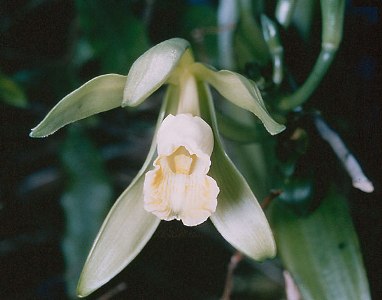Mention vanilla and the name people often associate with this specialty ingredient is Virginia Dare. I’m sure many of you recognize the bottle found in your mother’s or grandmother’s kitchen carrying the young, innocent face of a 16th century young woman.
Now many people may not know that Virginia Dare was the first English baby born in the colonies, the daughter of Eleanor and Ananais Dare. Unfortunately, Virginia happened to be born in Roanoke Colony, the ill-fated settlement that disappeared shortly after its founding.
And I have a feeling that most people don’t know that vanilla originally came from the New World, its origins going back to the pre-Columbian Mesoamerican era. Originally cultivated by the Mayans, it was the Aztecs that came up with the idea of combining vanilla and chocolate together.
What most people also don’t know is that despite the Spanish being able to bring vanilla and chocolate to Europe, it took nearly three centuries before anyone figured out how to pollinate this particular spice. As Henry Todd, v.p. – international for Virginia Dare, the Brooklyn-based vanilla and flavor company, explained, the vanilla orchid in Mexico happens to be pollinated by the Melipone bee.
Curious enough, you might say. Well, indeed, since that’s the only bee that can successfully pollinate the orchid, which, upon being “buzzed,” produces a vanilla pod. No bee, no pods.
I had this conversation with Todd at a dinner gathering sponsored by Virginia Dare for the media during the most recent IFT (Institute of Food Technologists) earlier in July. Todd, who’s lived and worked in Madagascar for a good portion of his life, provided a first-person account of not only the vanilla bean’s history, but also of what life’s like in Madagascar.
But back to those bees and vanilla orchids. According to Todd, there’s a very narrow window for pollination to occur, since flowers on the plant only bloom one day of the year, essentially from dawn to dusk.

|
| Flat-leaved Vanilla (Vanilla planifolia) |
Those Melipone bees had it figured out, but it wasn’t until 1841, nearly 300 years after Cortez brought cacao beans and vanilla pods to the Spanish court, that a young black slave, Edmond Albius, invented a technique for pollinating vanilla orchids quickly and profitably.
By using a thin stick or a blade of grass, he deftly manipulated the plant’s female and male parts with his thumb to pollinate the bloom. In doing so, he enabled vanilla plants to be cultivated outside of Mexico. Despite his discovery, Albius never profited from his ingenuity and died in poverty.
Poverty happens to be a way of life for many Madagascans, although there’s a wealthy and middle-class elite amongst those of Chinese and Indian descent. Vanilla also happens to be a critical crop for the island republic; about 80 percent of all of the world’s vanilla comes from Madagascar.
Like cacao, vanilla isn’t the easiest crop to process. Hand pollination is only part of the story. Typically harvested in June, the bean undergoes scalding, drying, maturing, and hand-sorting. Like cacao, most of the farmers involved in vanilla beans (about 80,000) tend to be small.
And, as with cocoa, there’s a fine art to selecting good vanilla.
During the pre-dinner presentations, Todd revealed that Virginia Dare had entered into a partnership with Soarary, a family-owned company involved in the purchase, curing and exporting of vanilla. The partnership provides Virginia Dare with a fully integrated vanilla supply chain.
Going local also strengthens the company’s ability to ensure the availability, quality and consistency of its vanilla extracts and flavors during market instability and supply shortages. We all can remember when vanilla was near the price of gold several years ago.
The local connection also provides vanilla customers with enhanced traceability and sustainability guarantees. And finally, it should help the farmers, which these days takes on even greater importance for confectionery producers as well as consumers.
Anyway, just thought you might enjoy learning more about vanilla, probably the second most expensive spice in the world. As I’ve mentioned before, confectionery manufacturers not only have to talk traceability and sustainability to consumers, they’ll have to mean it as well.

